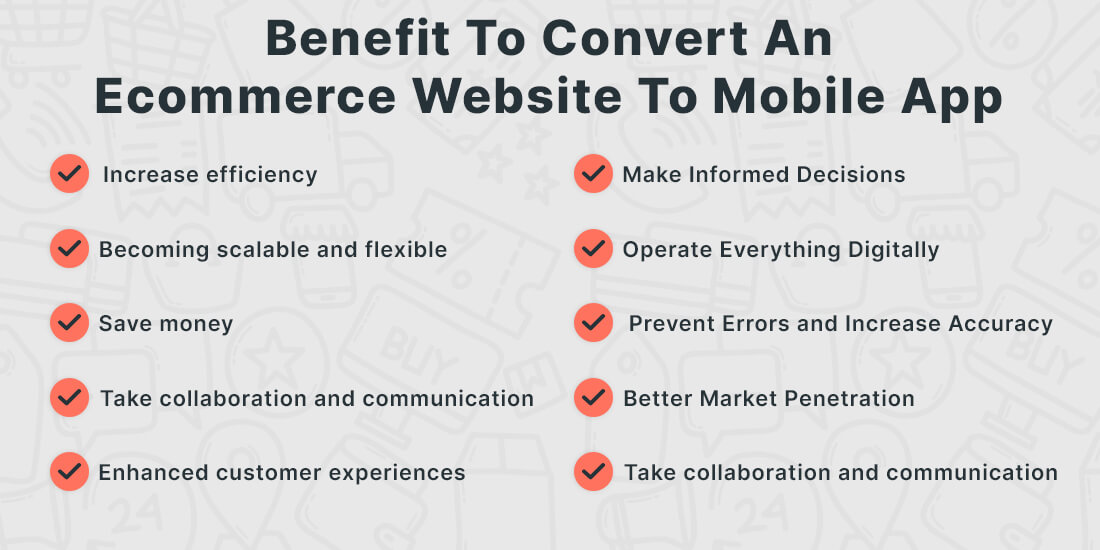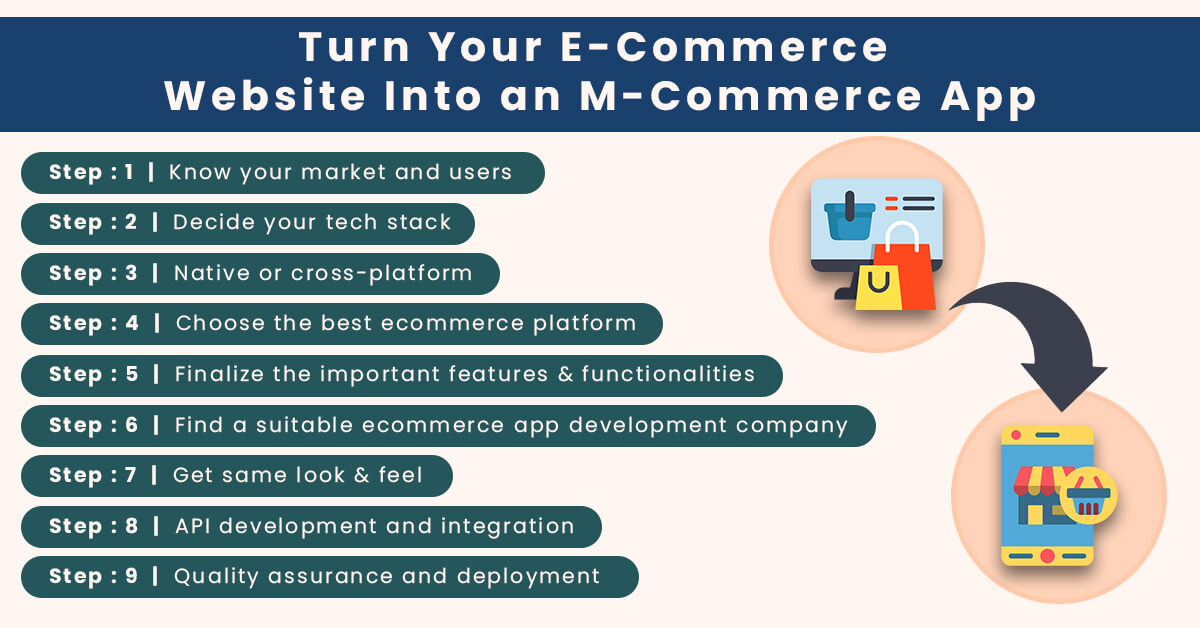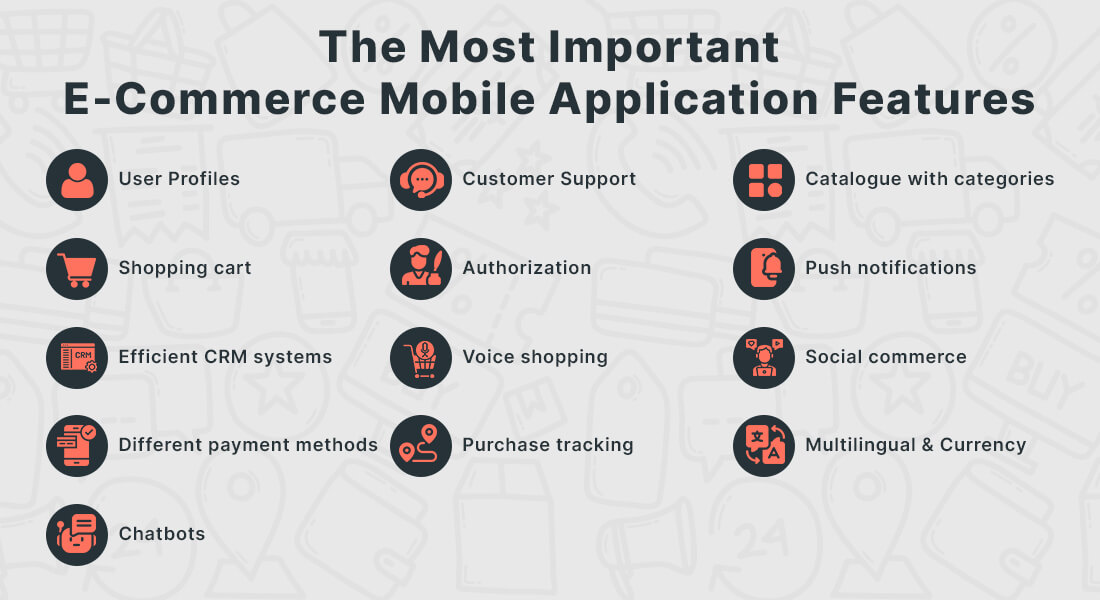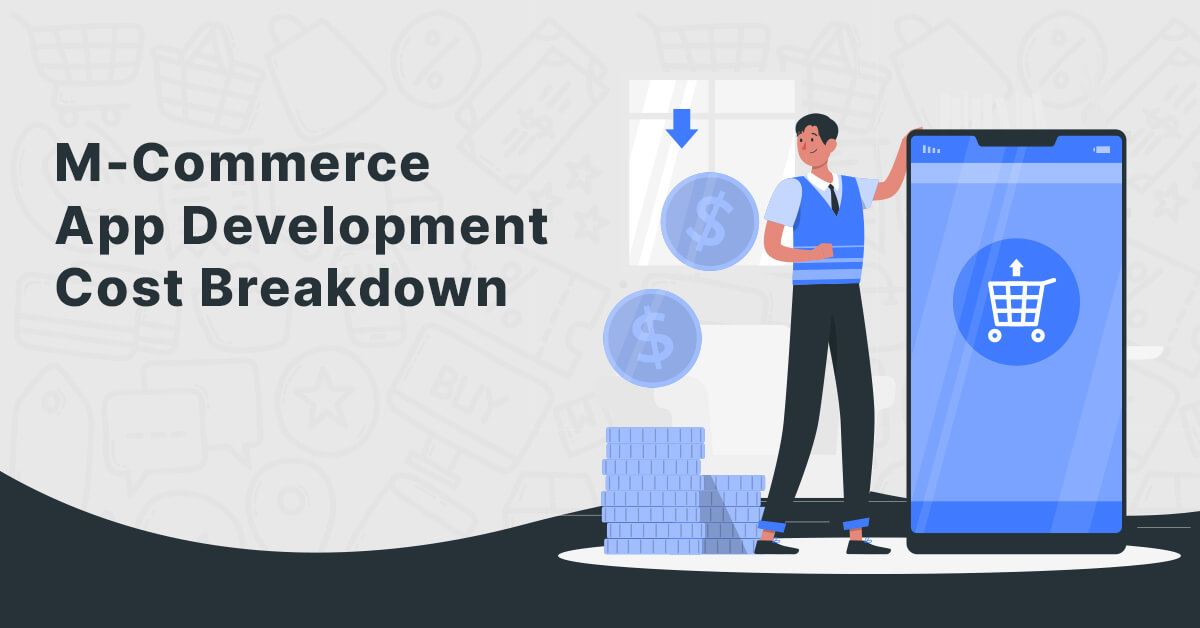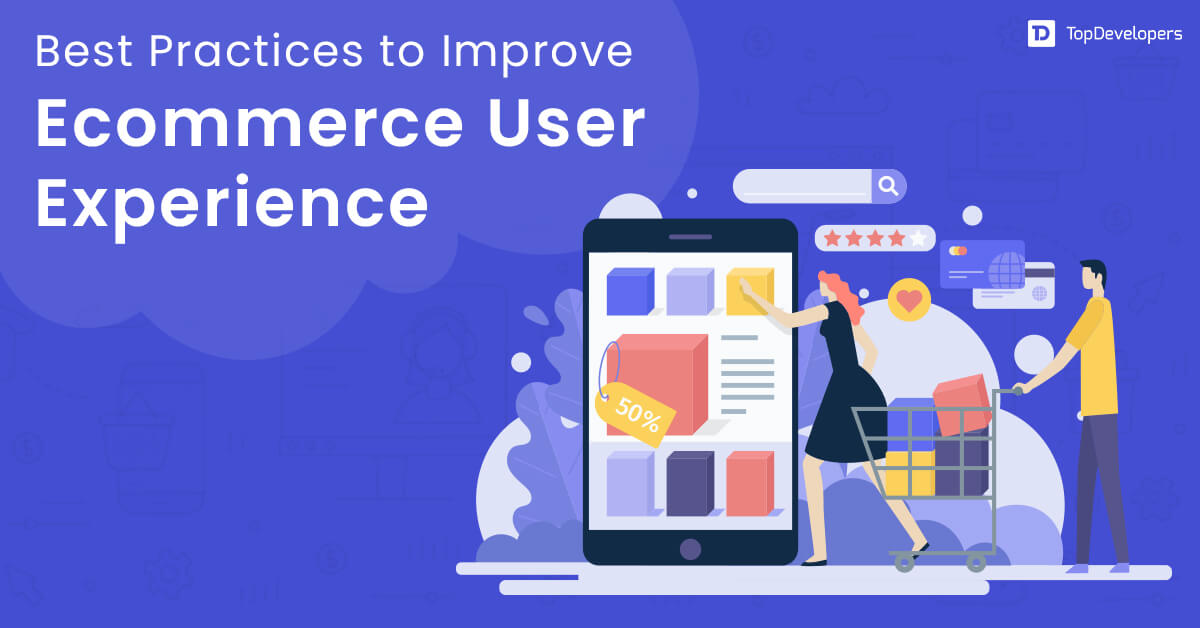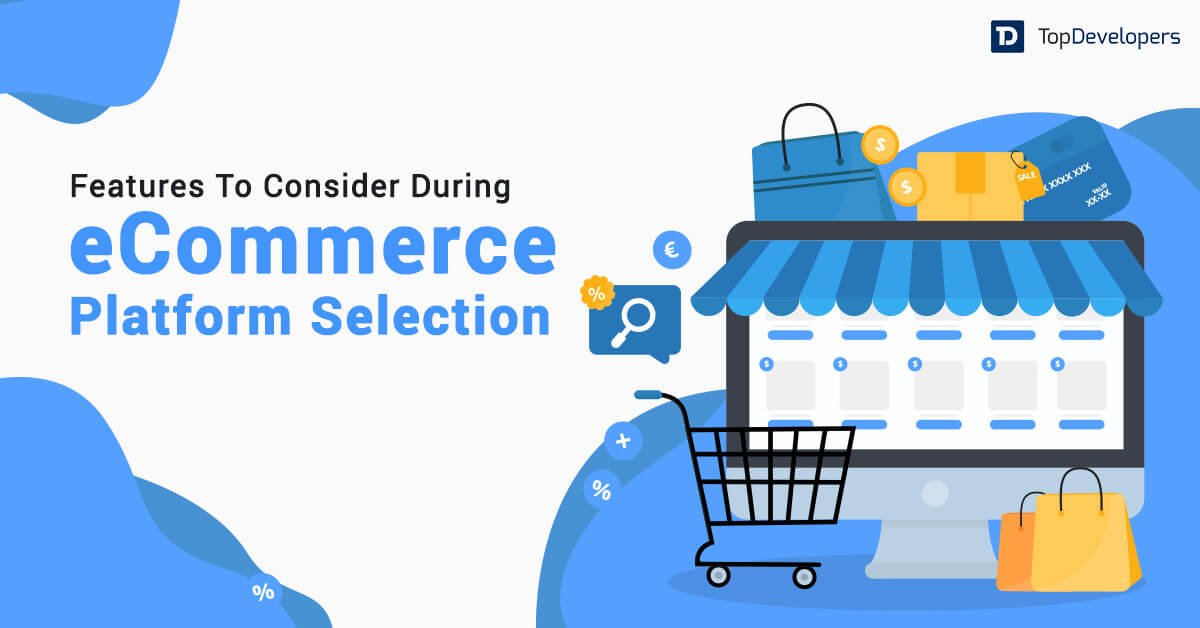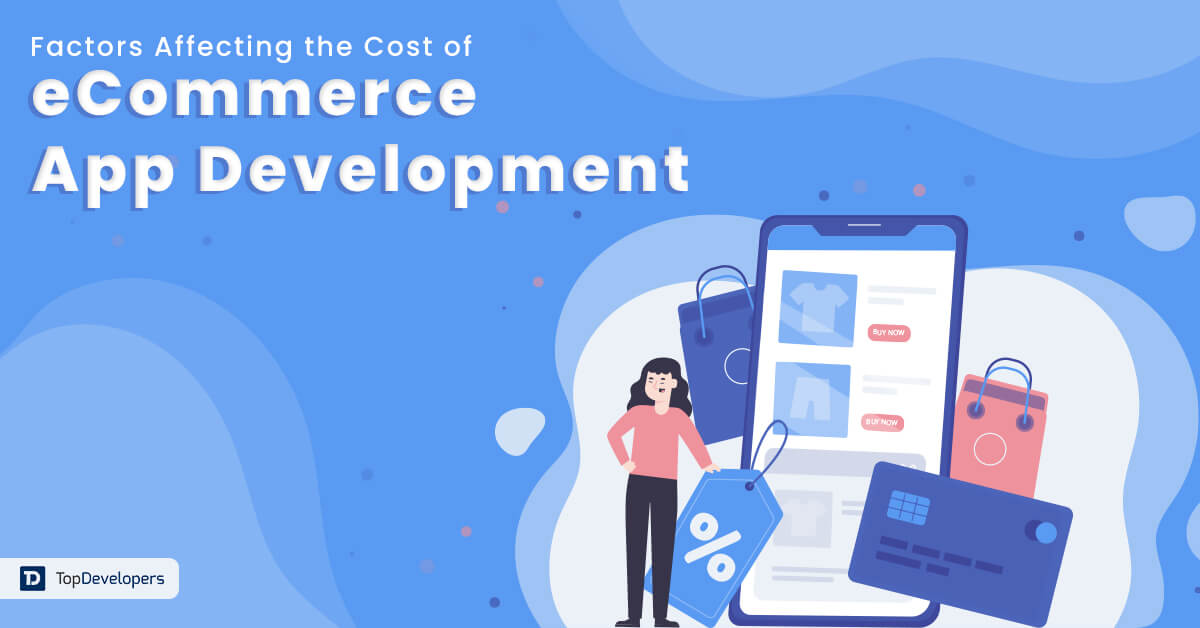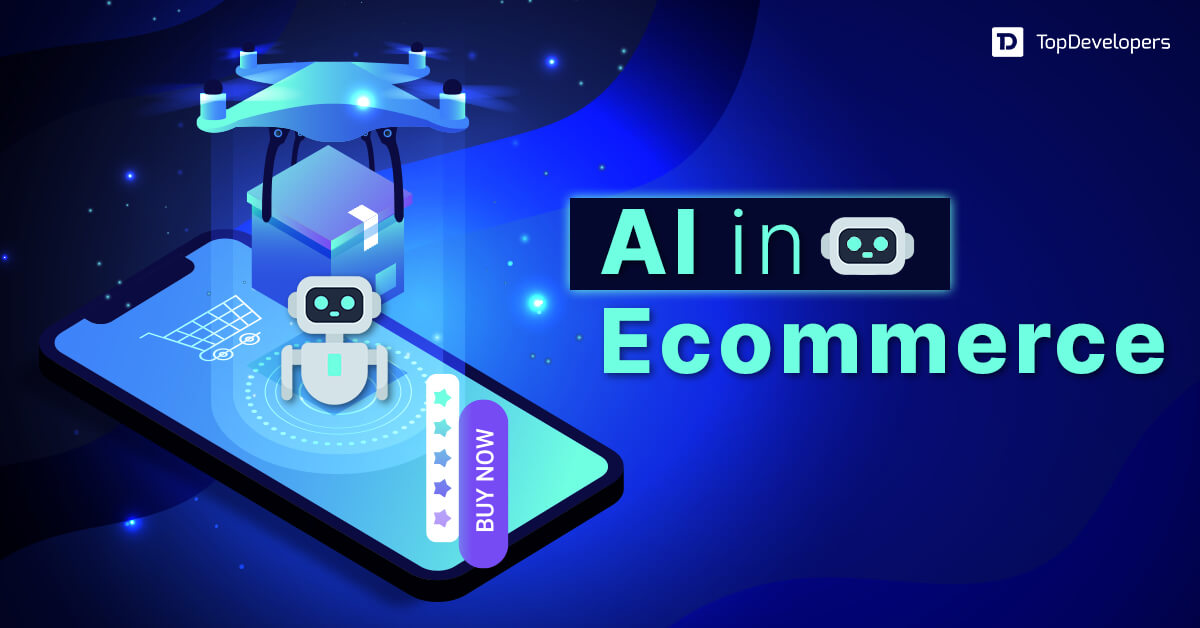
If you are looking for a guide to transforming your eCommerce website into an m-commerce app, then you have come to the right place. In this blog, we have detailed the process you need to adopt to achieve the website-to-mobile commerce solution. We have also added a list of must-have features in your m-commerce app that will ensure success for your business in the cut-throat competition arena of eCommerce.
As the eCommerce market grows rapidly across the world, consumers, especially from developing nations, are quickly shifting towards mobile commerce.
Insider Intelligence predicts that m-commerce sales will hit $534.18 billion, or 40.4% of e-commerce sales in 2024. The devices that are contributing the most to M-commerce sales is smartphone and tablet. The Smartphone accounts for nearly 87.2% of m-commerce sales which indicates the m-commerce trend is synonymous with the smartphone trend. Even, tablet m-commerce is not behind. Tablet m-commerce sales are expected to reach $54.01 billion by 2026 due to improved shopping experience.
Here are a few players who have nailed it in 2023 in the m-commerce arena:
- Apple
- Costco
- Walmart
- Kohl’s
- Nordstrom
The convenient experience of shopping from a smartphone increased smartphone and internet penetration in developing nations. The cost-effective nature of smartphones, as opposed to desktop computers, are the reasons that have helped boost m-commerce sales in recent years. With the onset of technologies like 5G, the trend will continue and give an impetus to mobile commerce.
In this write-up, we will have a look at the transition process from an eCommerce store to a mobile commerce app. Although expert eCommerce developers will aid you in the smooth transition process, there are other factors that you need to look into before you proceed.
First, let’s check out various reasons that will encourage you to launch a mobile app for your eCommerce business.
Table of Contents
- Why convert an eCommerce website into an eCommerce app?
- Tips to successfully Convert eCommerce website into a Mobile App
- How to convert your eCommerce website into an m-commerce app?
- Step: 1 – Know your market and users
- Step: 2 – Decide your tech stack
- Step: 3 – Native or cross-platform
- Step: 4 – Choose the best mobile commerce platform
- Step: 5 – Finalize the important features and functionalities
- Step: 6 – Find a suitable eCommerce app development company
- Step: 7 – Get the same look & feel
- Step: 8 – API development and integration
- Step: 9 – Quality assurance and deployment
- Differences between e-commerce and m-commerce
- Must-have features of a mobile commerce app
- How much does it cost to make a successful m-commerce app?
- Progressive Web Apps – When you need both: Website and App for your ecommerce business
- Take the decision
Why convert an eCommerce website into an eCommerce app?
Some of the world’s top eCommerce companies already have a mobile app. An eCommerce mobile app offers many game-changing benefits as compared to an eCommerce website. We have enlisted some of the most prominent benefits that you will find with an eCommerce mobile app as compared to an eCommerce website.
Mobile marketing opportunities
M-commerce apps provide mobile marketing opportunities in various forms. It enables businesses to send push notifications directly to users’ devices, which is a powerful marketing tool for notifying users about promotions, discounts, new product arrivals, and special offers in real-time. E-commerce apps can access a user’s location, allowing businesses to send location-based promotions and offers. Location-based marketing is one of the mobile commerce strategy trends that’s expected to help businesses succeed.
Integrating mobile wallets within the app simplifies the checkout process and can be used to offer exclusive discounts or cashback promotions to users. It allows users to share products, deals, or their shopping experiences on social media directly from the app. The user-generated content can serve as valuable marketing material.
Better Personalization
M-commerce app development is a step towards enhancing personalization, which ultimately leads to improved user engagement and user experience. Mobile apps for e-commerce stores can employ recommendation algorithms that analyze user interactions and behavior. This suggests products related to what users have previously viewed or purchased, increasing the chances of making relevant recommendations that lead to purchases.
In addition to personalized recommendations, custom loyalty programs reward customers for their repeated engagement and purchases. Users can receive personalized offers and discounts based on their loyalty tier or purchase history, which increases the conversion rate. The adaptive search functionality predicts user intent and offers relevant search suggestions, which delight users.
Valuable customer insights
The m-commerce apps provide valuable customer insights, which can be instrumental in optimizing business strategies and enhancing the overall shopping experience. Tracking user behavior, purchase history, browsing patterns, abandoned cart analysis, and app usage data helps to identify the friction points that need to be fixed or improved.
Say, utilizing heatmaps and click tracking tools helps visualize where users tap, scroll, or interact the most within the app. This data helps in optimizing the app’s user interface and layout. With sufficient historical data, apps can employ predictive analytics to forecast future user behavior and trends.
Wider reach
The M-commerce revolution will help businesses tap into mobile user base, improve discoverability, and more, which results in broadened user reach. The mobile app for e-commerce shop makes it convenient for mobile users to access products/services. Having an app presence on popular app stores like the Apple App Store and Google Play Store can increase the brand’s visibility.
The discovery mechanisms provided by app stores, including category rankings, featured apps, and search functionality help optimize app store listing, which improves discoverability and attracts more users. If a web-based eCommerce platform is also offered, apps can provide cross-device syncing, allowing users to seamlessly transition between mobile and desktop shopping experiences.
Increase your app store visibility
Contactless Payments
M-commerce apps facilitate various contactless payment options, which have become increasingly important in today’s digital shopping landscape. The eCommerce apps can integrate popular mobile wallet services such as Apple Pay, Google Pay, and others, offer in-app payment processing, support contactless card payments, and QR code payments, and enable one-click checkout. This streamlines the purchase process and provides a seamless and secure checkout experience.
E-commerce apps can store users’ payment methods securely, making it convenient for them to make repeat purchases without entering payment details each time. This feature reduces friction during the checkout process and encourages users to complete transactions quickly.
Improved conversion rates
Mobile commerce apps are designed to provide a more user-friendly, personalized, and convenient shopping experience, which can lead to higher conversion rates compared to websites. Faster loading times and responsive design contribute to a more pleasant shopping experience, which can motivate users to make purchases.
Offline accessibility ensures that users can explore products and add items to their cart anytime, increasing the chances of conversion once they regain connectivity. That’s why e-commerce app development companies suggest complementing e-commerce stores with m-commerce stores to intensify conversions.
Saves time
You stand to lose a whopping 49% of your visitors because of the slow load times of websites. This is because the human attention span is dropping, and at 8 seconds, it is now lower than the goldfish. With an eCommerce website, you will lose the battle as the average loading time of an eCommerce website is 10 seconds.
A mobile commerce solution saves time because the app loads faster as compared to websites. Faster loading time normally translates into increased sales velocity for your eCommerce business.
Brand recognition
An eCommerce app allows the brand to easily catch the attention of its users through features like push notifications. Push notifications can boost the app retention rate by 300 to 1000%. Mobile eCommerce stores can lure customers towards their stores by offering great offers, deals, and coupons sent via push notifications. You can also integrate various social media platforms into your mobile apps and allow your customers to discuss your products.
Enhanced customer experience
Technologies like AR (Augmented Reality), AI (Artificial Intelligence), and VR (Virtual Reality) integrated within your mobile application can help to boost your eCommerce business.
One of the major questions of users of products like makeup is, how would it look on me? Using modern technologies like AR, an m-commerce app can allow users to try makeup virtually from the convenience of their sofa. Brands like Sephora have already tried this successfully.
By using AI-enabled targeting tools, you’ll be able to know which leads are worth pursuing, where you can find them, and how you can engage with them effectively. AI-enabled chatbots help customers get quick resolutions of their issues, improving the customer experience exponentially.
Data analytics and better conversion rate
An eCommerce mobile app can help you easily gather relevant data about your customers. This data is related to the persona and buying behavior of your customers. Data gathering allows you to build targeted promotional campaigns, develop a better mobile commerce strategy, and deliver personalized offers and other content to your users.
As an eCommerce business owner, one of the most important eCommerce metrics that you should track is the conversion rate. The one thing that tilts the scales in favor of an eCommerce mobile app instead of an eCommerce website is the fact that mobile apps tend to have a better conversion rate.
Features like push notifications assist in improving the conversion rate. Moreover, mobile apps can leverage device features like cameras and GPS sensors to boost the conversion rate.
Tips to successfully Convert eCommerce website into a Mobile App
Converting a website into a mobile app can be a valuable step, which helps in expanding mobile presence and reaching a wider audience. However, the decision for conversion cannot be taken lightly, and considering a few factors ensures a successful transition and a positive user experience.
Here are several important factors to keep in mind before making this transition:
Optimize Costs
Estimate the costs involved in ecommerce app development, maintenance, and marketing in advance, which helps in knowing the necessary budget to have for supporting your app. Assess whether your current development team has the skills and expertise required for ecommerce app development or if you need to hire remote developers.
There is another way to diminish development costs is to use no-code platforms that eliminate the need to hire developers and reduce app development costs to half.
Prioritize E-Commerce Features
Once you have finalized the app development approach for your eCommerce business, the next step is to evaluate the feature’s priority and incorporate features in the mobile app accordingly.
Determine which website features are essential for the mobile app and prioritize their implementation. It helps in deciding how you want to move ahead, either building a simple app with basic features that are enhanced gradually or converting the complete website into an app. The former approach helps in understanding what’s engaging the users and then the app’s functionality and design is planned accordingly.
Create Mobile-First Design
You cannot convert a website into a mobile app in as-is condition due to differences in screen sizes and resolutions. Redesign your website user interface to fit the mobile platform. Mobile apps require a different design approach compared to websites.
Consider how users will interact with the app using touch gestures, such as swiping, tapping, and pinching. It helps in creating m-commerce UI that is user-centered and appeals to the target audience.
How to convert your eCommerce website into an m-commerce app?
When you start your process of converting an eCommerce website into a m-commerce app, there are many phases that you will need to take care of. We have mentioned below a suggested process to complete the transition smoothly.
Step: 1 – Know your market and users
Although you might have done market research and would have sufficient knowledge about your users when you started your ecommerce website, it is still a good idea to revisit this critical step before you embark on your m-commerce journey.
Conduct thorough research about your target audience and get data about their
- Demographics
- Geographical location
- The platforms (iOS or Android) they are on
- Their likes and dislikes
- The products they use now
- The features they would love in an m-commerce app
Once you do a thorough analysis of the market and your customers, you will be able to build an e-commerce mobile app that your users would love.
Step: 2 – Decide your tech stack
The tech stack directly affects the cost of your eCommerce mobile app and is a critical step of any e-commerce app development process. To make your decision easy, you should first try and find out the kind of device (Android or iOS) that your target audience uses and the geographical area where your target audience resides. You should also think about what type of mobile app you would prefer for your e-commerce business Android, iOS, or Cross-platform. It will help you choose the top tech stack for your mobile app.
Ask the following questions to yourself before you finalize the tech stack.
- Will the tech stack allow us to build a scalable m-commerce app?
- Are developers easily available for the current tech stack?
- Is the tech stack reliable and tested?
- Is there a big and supportive developer community available to help with the technical issues in case the developers get stuck?
- What’s the best combination for my business niche?
Consult with eCommerce developers to select the most appropriate tech stack according to your business needs from TopDevelopers.co.
Step: 3 – Native or cross-platform
An important decision that you will need to make for your m-commerce app is whether to go for native or for cross-platform app development.
When to choose Native app development?
When an app demands high performance, responsiveness, and efficiency, native development is often the best choice. Native apps are optimized for specific platforms (iOS or Android), allowing them to leverage device-specific features like GPS, camera, sensors, or advanced APIs and deliver superior performance.
When businesses want to provide the best user experience on each platform (iOS and Android), native development allows to tailor the app’s design and functionality to the unique characteristics of each platform. Native apps can be published on official app stores like the Apple App Store and Google Play Store, making it easier to reach a broad audience and gain visibility.
When to choose cross-platform app development?
Cross-platform app development is an excellent choice when businesses have limited development resources, such as a small development team or budget constraints. This development approach allows to build and maintain a single codebase for an app that runs on multiple platforms.
It also helps bring apps to market quickly using cross-platform development frameworks like React Native, Flutter, or Xamarin that offer faster development cycles. It ensures a consistent user experience across different platforms. It minimizes the ongoing maintenance effort and costs with simplified codebase management, as updates and bug fixes need to be applied to one codebase rather than multiple separate ones.
The choice of native or cross-platform app development really depends upon your requirements. You should consult an expert m-commerce app development company to ensure that you choose what is best for your business.
Step: 4 – Choose the best mobile commerce platform
In case you do not want to develop an app from scratch, then you can opt to develop the app on an mcommerce app development platform like Shopify. Before you go scouting for the best mcommerce app development platforms, confirm with your technical partner if it would be feasible to transform the eCommerce website to an m-commerce app using an m-commerce platform.
Before you finalize the eCommerce platform, you should have a thorough look at the features of e-commerce platforms, select the platform that is the best choice for your business and then make a choice.
Top E-commerce Platforms to Create Mobile Apps
Shopify
When it comes to popularity, Shopify takes the lead with more than 1.7 million merchants choosing to sell their products on Shopify. Shopify has an impressive range of designs that covers a majority of eCommerce niches.
The issue, however, with Shopify is that most of these templates are not free. However easy it may seem, with more than a million Shopify store owners out there, you will need the support of Shopify app developers to build a Shopify m-commerce app that stands out from the competition.
WooCommerce
WooCommerce is another popular m-commerce app development platform. WooCommerce provides great flexibility as all kinds of businesses, regardless of their niche, can build a mobile app that suits their needs on WooCommerce. Another benefit of WooCommerce is that the platform offers a high degree of scalability, and a growing eCommerce business does not need to worry about the business expanding past the plugin’s ability.
With WooCommerce, e-commerce businesses would need to shell out money for most of the extensions. If you choose to go with WooCommerce, then ensure that you avail the services of expert WooCommerce developers to build a stable and secure application.
Magento
Magento has a host of features that allow m-commerce store owners to manage multiple stores with multi-currency and multilingual support. The fact that it is mobile-friendly, scalable, and has a big community of users makes Magento a very popular eCommerce platform.
One of the factors to consider when you choose Magento to build mobile app development for your ecommerce store is that the Magento apps are difficult to customize and have a slow loading time as compared to other mcommerce platforms. Hire Magento developers to overcome the limitations of Magento and build a high-quality m-commerce app.
BigCommerce
Unlike other m-commerce platforms, BigCommerce does not put a limit on the number of products that one can put up in their stores. Moreover, BigCommerce proves to be economical for products that have lower margins and more transactions as BigCommerce charges a very low transaction fee. These reasons make BigCommerce app development a popular choice.
With BigCommerce, although many integrations will be free to install, you will have to pay money to use the service. Hire BigCommerce experts to ensure that you leverage the power of BigCommerce in the most optimum way and develop a robust m-commerce app.
Step: 5 – Finalize the important features and functionalities
Once you have decided whether you want to go for a stand-alone app or want to build your m-commerce app on an eCommerce platform, you will then need to finalize the important features and functionalities.
Step: 6 – Find a suitable eCommerce app development company
Unless and until you have an in-house eCommerce app development team, it would be wise to hire professional mcommerce developers. This is because top m-commerce app developers would have the necessary experience and skill set to ensure that you get a bug-free and robust mcommerce app.
To select a proper eCommerce app development team for your mobile app, you will need to check their work portfolio, take reference of their clients, check their client reviews and have a detailed discussion regarding their work process and the kind of resources they possess.
Sign an NDA to ensure that your data does not leak, and always insist on testing the app thoroughly before you accept delivery of the m-commerce app to get a robust application.
Step: 7 – Get the same look & feel
A consistent look and feel of your eCommerce website is important from a branding perspective. If your mcommerce app is too different from your eCommerce website, then it would leave your old users confused as they are accustomed to a particular layout.
When we talk about maintaining a consistent look and feel, it is not limited to the color palettes, the fonts, the images, and the layout of the buttons. The entire user experience should be consistent on your ecommerce website as well as your mcommerce app.
Step: 8 – API development and integration
In an eCommerce website, CMS plays a critical role in making the process of website development easy. With CMS, there is no security issue, and the data exchange is seamlessly done between different software components like database, web server, frontend, and platform.
The same cannot be said about mobile apps. This is because, with mobile apps, the developers do not build a closed system with a database. Hence in the case of a mcommerce app, you will need to utilize APIs (Application Programming Interface) for successful data exchange with the database. To build a mobile app from the same database as your eCommerce website, the developers will need to build different APIs.
Step: 9 – Quality assurance and deployment
Testing is an important part of the eCommerce mobile app development process. As m-commerce app owner, you would not want your mobile app to crash at a critical point like on a big sale day. That is why you need to ensure that the app you get is properly tested on all parameters.
Ideally, you should test the mcommerce app for worst-case scenarios if possible before you take the delivery. Both manual, as well as automated testing methods, can be employed to ensure a fail-proof m-commerce app. Bad quality assurance is one of the major factors why most e-commerce platforms fail.
Once the testing phase is successfully completed, it’s time to take your mcommerce app to your users. Although there are many third-party app stores and other platforms available, the Apple app store and the Google Play Store are the two major platforms to upload your mcommerce app. Depending upon your app platform upload it on the Apple app store or the Google Play Store, or on both.
Differences between e-commerce and m-commerce
| Differences | E-commerce WEBSITE | M-commerce apps |
|---|---|---|
| User experience | Designed for large screen for detailed view | Tailored for small screens with a mobile-friendly layout |
| Platform | Accessed through desktop and web browsers | Smartphones and handheld devices |
| Device dependency | Not limited to a specific device | Heavily dependent on mobile phones |
| Mobility | Responsive websites accessed via mobile | Yes |
| Reachability | Everywhere | Limited due to active internet connection needed |
| Location tracking | Limited | Unlimited |
| Payment gateway | Digital wallet, credit card, and bank transfer | In-app purchase, mobile wallet, Qand carrier billing |
| App store presence | No | Yes |
| Device integration | Limited | Extensive integrations are feasible |
Must-have features of a mobile commerce app
Now that you know the process of making the transition from an eCommerce website to a m-commerce app, you would be raring to go and start the process, right? Sure, you can start the process by employing an efficient mCommerce app development company, but make sure to have the following user-friendly features to succeed in the mobile commerce arena.
User Profiles
M-commerce apps allow users to create accounts or sign in with social media profiles. Thereafter, it enables users to create and manage their profile information, including shipping addresses and payment methods. With profiles, users can also see the history of their past purchases, repeat orders, and analyze their spending.
Customer Support
Provide instant response to the users with excellent customer support through email, live chat, phone, and others. It makes users shop incessantly from the ecommerce app. You can also choose to add a chatbot in live chat to provide 24*7 support to your customers which will help you to get their trust and increase the retention rate of your m-commerce app.
Catalogue with categories
Display a well-organized and searchable product catalog with detailed descriptions, filters, sorting options, and categories to help users find products easily. A well-organized catalog with multiple categories that are easy to browse will make users come repeatedly to your e-commerce mobile app.
Shopping cart
Offer a user-friendly shopping cart that displays added items, quantities, and prices, which facilitates easier editing, updating, or removing items from it. Also, implement shopping cart synchronization across devices and platforms.
Authorization
Easy and secure access plays an important role in determining the success of an e-commerce mobile app. You might want to add social signup to ensure that your users have easy and secure signups. By providing the social sign-in feature, you will make life a little easier for your users as they will not need to remember the user ID and password of another app. Also, with social sign-in, you will be able to easily verify the identity of the users, and this will improve the security of the m-commerce app.
Push notifications
Push notifications are an efficient way to send notifications regarding discounts, offers, and delivery details to your mcommerce app users. This feature is a good way to boost engagement and drive users toward your app. It leads to enhanced user engagement and will help you build a loyal user base. The overwhelming advantages of push notifications make it a must-have feature in your m-commerce app.
Efficient CRM systems
A brand that engages with its customers enjoys a 90% higher conversion rate, and its customers tend to spend 60% more on average on every purchase.
A major benefit of an eCommerce CRM (Customer Relationship Management) is it enables to identify sales patterns by analyzing customer information. The following are just a few metrics that you will be able to record and analyze through a CRM.
- Customer click-through rate
- Conversion rates
- The products your customers are interested in
- Email subscription opt-ins
Voice shopping
Voice commerce is a technology that allows users to search and shop from their smart devices. Voice-activated assistants like Amazon Alexa, Google Assistant, and Apple Siri have made voice shopping easier for online shoppers. According to data from Statista, voice shopping sales rose to around $20bn by the end of 2022 compared to just $2bn in 2018. Adding such a feature to your e-commerce mobile app is going to increase your user experience (UX) positively.
Social commerce
Social commerce is one of the emerging mobile commerce trends that will make a big impact on digital commerce in the future. According to a survey conducted by Magento, around 60% of the users admitted that 25% of recent purchases were affected by social media. Social commerce is taking off in a big way, and you wouldn’t want to miss out. So consider adding a social commerce feature to your m-commerce app so that users can easily share a product they like on your app with their friends and family members.
Different payment methods
On average, around 7 out of 10 shoppers abandon their shopping carts. The shopping cart abandonment rates are so high because of the many hurdles that the customers face during the process. A major hurdle is the lack of available payment options during the checkout process.
There are multiple payment options like credit cards, debit cards, internet banking, PayPal, and Cash on Delivery (COD) available to the consumer today. Offering more payment options will take the hesitation out of the purchase.
Purchase tracking
The order tracking system plays a key role in enhancing the customer experience. The eCommerce order tracking system includes features like shipment tracking, estimated delivery dates, and frequent updates on the order status. The order tracking system will let your buyers know when to expect their delivery and will also help you alleviate their concerns whenever there is an unexpected delay.
Multilingual & Currency
Only 4% of the world’s population speaks English as their first language. If you want to build a truly global app, then you need to integrate support for multiple languages into your app.
Along with multilingual support, you also need to provide multi-currency support to your users so that they can buy in their country’s currency without any hassle. You can tie up with local currency converting agencies, this will reduce the payment charges that your users need to pay for products shipped from another country.
Chatbots
Around 6 out of 10 customers would prefer to contact a business through chatbots. Many eCommerce companies today utilize chatbots to improve their customer service.
Chatbots provide the following benefits;
- Help you boost your customer service
- Reduce investment in hiring human customer care executives
- Chatbots make your app more interactive
- Help your customers 24*7
Apart from customer service, chatbots can streamline many other interactions in an eCommerce business.
How much does it cost to make a successful m-commerce app?
Before you reach out to a development partner, the businesses should set aside a budget for transitioning the E-commerce website to an e-commerce mobile app that requires them to know the estimate. Defining the estimate involves a couple of factors such as features, complexity, support, developers’ location, and more. Also, to avoid unexpected, hidden charges, it’s better to include detailed project requirements in the document.
A look at the top factors that affect e-commerce mobile app development cost
Project complexity: As the number of screens to build increases with a list of features, it takes more time to engineer the m-commerce application. Increasing complexity surges the development cost accordingly.
Developer requirements: The need for app development team size and proficient developers with different levels of expertise and experience relies on the project type. The bigger team with senior developers’ requirements increases the cost of converting an e-commerce website to an e-commerce mobile application.
Choice of the platform: Choose the mobile platform depending on your target audience’s preferences. Developing the m-commerce app for two platforms natively would cost more than opting for a cross-platform app development approach.
Features consideration: Building each feature takes time and as the number of features increases, the cost to build your mcommerce app increases as well.
Location of the developers: When you outsource your project and hire ecommerce mobile app developers from a specific country the charges differ. For example, hiring ecommerce app developers from India will be more cost-efficient than hiring one from the USA.
Additional charges: When ecommerce businesses opt for support and maintenance services or digital marketing services, it shoots up the development cost.
What’s more? The price range you are expecting
Despite reading all the parameters that impact the development cost of your m-commerce app, you still expect a price range in which the e-commerce app development cost comes in between. The simple ecommerce app development, with basic features and optimal UI, cost start between $15,000 to $30,000. The complex ecommerce app development, with advanced features and complex UI, costs start between $40,000 to $80,000. Increasing complexity uplifts the cost of conversion proportionately.
Progressive Web Apps – When you need both: Website and App for your ecommerce business
The businesses who haven’t jumped on the transition from e-commerce to m-commerce journey yet, and looking to have both- website and mobile app, Progressive Web Apps (PWAs) are an excellent option. PWA helps businesses get best of the both worlds. They are accessible on a wide range of devices and platforms, including desktops, smartphones, and tablets. So, users can access the PWA through web browsers, making it versatile and eliminating the need to develop separate apps for different operating systems (iOS, Android, Windows).
PWAs do not require users to download and install them from app stores. This eliminates friction and encourages users to engage with the app immediately without going through the installation process. The best thing is developing and maintaining a PWA typically involves lower costs compared to building and maintaining separate native apps for iOS and Android. This is because a single PWA can serve multiple platforms.
In this way, progressive web apps offer an attractive compromise, providing a seamless and cost-effective solution that caters to a wide range of users and devices for your ecommerce business.
Progressive Web Apps vs Native Apps: Which one is better for you?
Take the decision
As the eCommerce market grows rapidly, a mobile app is becoming a vital resource for all kinds of eCommerce businesses and online stores. As more and more desktop users get converted into mobile users, m-commerce is the place where all the action is. If you want to become or even remain successful in the eCommerce battleground, m-commerce should be your weapon of choice.
 Avantika Shergil
| Sep 25, 2023
Avantika Shergil
| Sep 25, 2023
An enthusiastic Operations Manager at TopDevelopers.co, coordinating and managing the technical and functional areas. She is an adventure lover, passionate traveler, an admirer of nature, who believes that a cup of coffee is the prime source to feel rejuvenated. Researching and writing about technology keeps her boosted and enhances her professional journeying.
